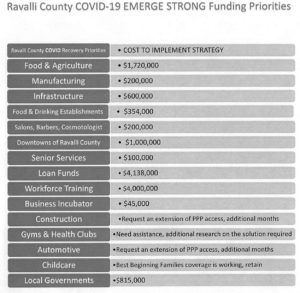 Ravalli County Commissioners last week officially adopted a COVID-19 Emerge Strong Plan which aims to serve as “a blueprint to emerge from the pandemic with renewed economic resilience and continue being a powerful engine for Montana’s economy,” according to the title of the report.
Ravalli County Commissioners last week officially adopted a COVID-19 Emerge Strong Plan which aims to serve as “a blueprint to emerge from the pandemic with renewed economic resilience and continue being a powerful engine for Montana’s economy,” according to the title of the report.
The plan identifies the major problem areas in the local economy that have been generated by the pandemic as well as outlining solutions, costs and a timeframe for helping sole proprietors, small businesses, small-medium businesses and large corporations. The hope is that Governor Bullock will fund the $22 million plan as the quickest, most efficient way to disperse some of the $1.25 billion in federal funds that the state has received to help mitigate the impacts of the pandemic on Montana businesses.
Julie Foster, Director of the Ravalli County Economic Development Authority, began working on the plan with state legislators Nancy Ballance and David Bedey and officials from the county and the city of Hamilton last April 18. Phone interviews were conducted with numerous business owners representing most sectors of the valley’s economy to find out what they were experiencing because of the COVID-19 pandemic.
“We spoke with new business owners and owners that have been in business for twenty years or more,” said Foster. She said businesses across the spectrum were critically impacted by COVID-19 and many were taking extreme measures aimed at starting over post-pandemic.
According to the report, the COVID-19 business implications have been severe. Sales have gone down, some accounts payable cannot be collected, revenue has been lost, the cost of doing business has increased, and some raw materials are not available.
On top of this, new processes for doing business are now necessary for the post-COVID economy. Cash planned for investment to capture opportunity has been spent instead reacting to COVID-19. Workers (existing and new) need training on new safety routines as well as innovations being made by adding new products, and processes. Foster said most businesses will need access to readily available, gap funding which will reduce the risk to their main lenders, the banks. She said many businesses have a customer base that is national and international. These businesses will not see a return to normal immediately, according to the report.
A summary of the report was delivered on April 23 to the Governor’s Task Force that was formed to make recommendations on how the state should spend the $1.25 billion in federal funds.
The Ravalli County Commissioners gave the plan a big push by officially adopting it last week but Representative Bedey told them at the meeting that he did not think it likely that the governor was going to write the county a check for $22 million. Both Bedey and Representative Nancy Ballance were critical of Governor Bullock’s lack of any statewide plan and the way he was “dribbling” the money out so slowly in such small amounts. Bedey told the commissioners that it was not likely that the governor was going to simply fund the plan.
“I think what we are going to see is that a series of funds will be set up for distribution to which we can apply, but there is not going to be a block of money come to Ravalli County,” he said.
“The best we can do now realistically is to have a plan in place and be checking the radar screen and be ready when these programs come forward.” He said there will probably be involvement by the Board of Investments with a loan program. “We need to be ready to engage the banks and Julie’s plan gets us ready to do that. We are not in the best situation but we are in a position to make the best of this,” said Bedey.
Foster said that the relatively small amount of federal dollars that have been released by the governor’s office are not enough. She called it a “band-aid approach.” She said the process was also going slow and noted the three-week delay in getting money through to the businesses that desperately need it. She said three weeks was simply too long for some small businesses to wait for an answer.
“It’s sad to see businesses closing up when the problems are solvable, but just not being solved in time,” said Foster. She pointed to the crucial work that the Hamilton Business Relief Fund and the Stevensville Business Relief Fund were doing in this regard with quickly raised and quickly dispensed local funds.
“The Stevensville and Hamilton Business relief funds are good examples of how getting money fast can save a business,” said Foster. She said the same thing could be done with the federal funding that the state is sitting on.
“Ravalli County has proven itself,” said Foster. “RCEDA has a long history of working with the county businesses.” She said the agency’s familiarity with the capabilities and capacity of local businesses enables it to assist in identifying the real needs in the community in order to emerge from this economic crisis in decent or even better shape than before. “I don’t know if the state will be able to trust us, but if they could, I think they would be very happy with that decision,” said Foster.
The plan is chock full of detailed information about every aspect of Ravalli County’s economy and presents a budget with priorities set for each category of use including businesses, infrastructure and local government.
The overall budget for the proposed recovery efforts comes to $22 million:
